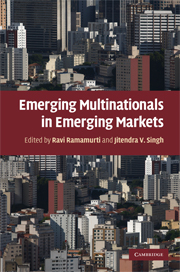Book contents
- Frontmatter
- Contents
- List of figures
- List of tables
- List of abbreviations
- List of contributors
- Acknowledgments
- Part I Introduction
- Part II Country Studies
- 5 Chinese multinationals: Emerging through new global gateways
- 6 Indian multinationals: Generic internationalization strategies
- 7 Russian multinationals: Natural resource champions
- 8 Brazilian multinationals: Surfing the waves of internationalization
- 9 South African multinationals: Building on a unique legacy
- 10 Mexican multinationals: Insights from CEMEX
- 11 Thai multinationals: Entering the big league
- 12 Israeli multinationals: Competing from a small open economy
- Part III Conclusions
- Index
- References
9 - South African multinationals: Building on a unique legacy
from Part II - Country Studies
Published online by Cambridge University Press: 03 July 2009
- Frontmatter
- Contents
- List of figures
- List of tables
- List of abbreviations
- List of contributors
- Acknowledgments
- Part I Introduction
- Part II Country Studies
- 5 Chinese multinationals: Emerging through new global gateways
- 6 Indian multinationals: Generic internationalization strategies
- 7 Russian multinationals: Natural resource champions
- 8 Brazilian multinationals: Surfing the waves of internationalization
- 9 South African multinationals: Building on a unique legacy
- 10 Mexican multinationals: Insights from CEMEX
- 11 Thai multinationals: Entering the big league
- 12 Israeli multinationals: Competing from a small open economy
- Part III Conclusions
- Index
- References
Summary
In the complex landscape of MNEs from emerging markets, the case of South Africa is peculiar in many respects. First, the history of apartheid created a historically unique economic structure in which deep poverty and highly advanced industry existed side by side. Second, some South African companies have traditionally maintained strong international connections, even under apartheid when they were by and large prevented from investing overseas. Third, South African MNEs have traditionally invested in other Commonwealth countries, including some high-income Organization for Economic Co-operation and Development (OECD) ones, much more than in fellow developing countries. Fourth, and somewhat paradoxically, the latter feature has not prevented South Africa from becoming a major source of international capital for many African countries.
This chapter provides an introduction to some of the key issues regarding outward FDI from South Africa. What limited literature exists on South African MNEs is mostly restricted to South African investment in the rest of the continent, and thus we hope to expand the understanding of the broader transnationalization strategies of South African firms (Gelb 2005; Goldstein and Prichard 2007). In doing so we seek to draw connections between South Africa's unique history of economic development, and the very particular patterns of transnationalization that have prevailed since the end of apartheid.
- Type
- Chapter
- Information
- Emerging Multinationals in Emerging Markets , pp. 244 - 279Publisher: Cambridge University PressPrint publication year: 2009



